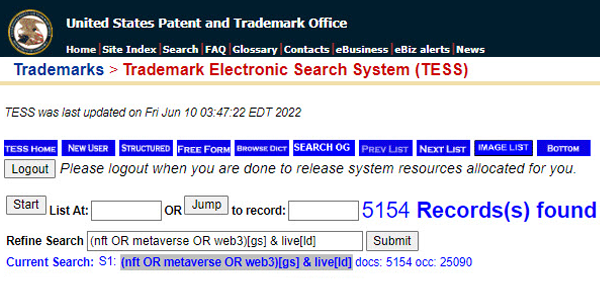A Guide to Trademark Registration for NFT Projects

A lot of people have asked me lately: can I protect the name of my NFT project with a trademark?
Absolutely!
Despite being a new technology, our “old” laws still apply. Obtaining a trademark registration on your NFT project is a great way to protect yourself in the marketplace.
NFTs, or non-fungible tokens, seem to be on the top of everyone’s mind lately. Not only are NFTs collectible, but some NFT projects also include additional benefits for the holder of these unique tokens – like early access to concert tickets or access to a private community.
For example, those who own tokens from the NFT project VeeFriends, created by Gary Vaynerchuk, own a unique collectible token that also grants them tickets to a yearly business conference hosted by NFT project creator, Gary himself. The VeeFriends NFT project demonstrates that NFT projects can be much more than artwork or collector’s items – they can be digital assets that provide their owners with other forms of value.
The trademark registration process for NFTs is the same as it is for any other product or services, however, NFTs present unique considerations for trademark registration. Here are four tips for starting the trademark registration process for an NFT project or collection:
1. Before dropping your NFTs, run a trademark search on your NFT project name.
In the traditional marketplace, investors comb through legal and financial records to ensure that they can trust the company, technology, or asset they are investing in. This “due diligence” is a necessary step for ensuring that the investment has value.
NFTs are no different. When deciding whether to invest in an NFT project, buyers need to feel confident that they can trust the creators. From an intellectual property standpoint, one way to instill confidence in buyers is by demonstrating that you’ve assessed the potential risks involved in selecting your brand’s name or logo.
Carelessness in selecting the branding for an NFT project can potentially have repercussions. If a trademark owner sends a cease-and-desist letter to an NFT creator or, worse, files a lawsuit against the creator, the entire project could be tainted and the value of the NFT could be affected.
To mitigate these risks, you should start the registration process by conducting a comprehensive search of the United States Patent Trademark Office (USPTO) database and state registries, as well as for common-law uses of your chosen brand. This search will provide insight into the landscape of existing trademarks that other companies may claim rights.
As of June 2022, over 5,000 trademark applications have been filed for non-fungible tokens.

The search will not yield results for trademarks that are only identical to yours, but will also include trademarks that are ‘confusingly similar’ for ‘related goods.’ Given the threshold of potentially conflicting trademarks, simply searching tmsearch.uspto.gov does not constitute a comprehensive search; your search should also include misspelled words, unique spellings, and similar sounds/meanings/impression words and phrases in the NFT space and the art and software spaces. You can learn more about comprehensive trademark searches here.
2. Begin the trademark registration process as early as possible.
Once you’ve completed the risk assessment, you should consider registering your project’s name or logo with the USPTO as soon as possible. Some things to consider before doing this are:
Who is the owner? Will you own it personally or will a business own it (such as an LLC, or corporation)? Ownership is a multi-factor determination that is beyond the scope of this article. Read more about trademark ownership here.
For NFTs, ownership can get complicated, as some NFTs are governed by a Decentralized Autonomous Organization, or a DAO – disclaimer: before putting a trademark in the name of a DAO you should consult with a trademark attorney with specialized knowledge in DAOs, as trademark ownership requires control, and if the DAO does not properly protect those rights, then the trademark can be damaged.
Once you’ve determined who owns it, then what exactly should you file for? The strategy around this is still evolving, so it makes sense to consider both downloadable assets (trademark class 9) and services (class 41 and/or 42, depending on the service being provided, e.g., private community access, assets for an online game, etc.).
What is your filing basis? One of the questions on a federal trademark application is regarding your filing basis. For U.S.-based companies looking to protect a NFT project, the most relevant choices for filing basis are “intent to use” or “in use.” Just as the name states, an “intent to use” filing basis means that the mark is not currently in use, but it will be soon. Likewise, “in use” means that the mark is currently being used.
Simply announcing an NFT drop is not enough to file an “in use” trademark application, but you can reserve your rights through an “intent to use” trademark filing. This filing basis will backdate your rights to your application date, even if your NFT project isn’t going to drop for several months.
There are dozens of other legal considerations that may need to be assessed before filing a trademark application for your NFT project. Trademark attorneys with experience in these types of filings can help refine the trademark application strategy to avoid issues with your application and ensure that you are properly protecting your NFT.
3. Avoid using intellectual property belonging to others.
It may be tempting to create a fan project based on your favorite DC or Marvel superheroes or to create virtual versions of luxury products that people love. However, using intellectual property that belongs to a third-party will almost always be a recipe for disaster. This includes names, brands, or creative assets that belong to others. We’ve already seen at least one lawsuit challenging the use of its trademark in an NFT project.
4. Be vigilant in the marketplace.
Although you are actively avoiding using the intellectual property of others in your NFT project, you should be aware of a disturbing trend in NFT marketplaces – the increased frequency of others lying about the ownership of copyrights and trademarks, for the purposes of selling NFTs that they did not create or own to unsuspecting buyers. Monitoring the virtual marketplaces and thoughtfully (yet aggressively) policing the unauthorized use of your intellectual property on them is an important aspect of intellectual property ownership generally – which equally applies to NFTs.
Do you need assistance with a trademark matter?
Contact an Attorney Today